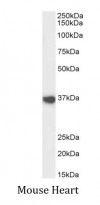ARG63158
anti-ATF4 antibody
anti-ATF4 antibody for Western blot and Mouse
Gene Regulation antibody
Overview
| Product Description | Goat Polyclonal antibody recognizes ATF4 |
|---|---|
| Tested Reactivity | Ms |
| Predict Reactivity | Hu, Rat, Pig |
| Tested Application | WB |
| Specificity | This antibody is expected to recognize both reported isoforms (NP_001666.2; NP_877962.1). |
| Host | Goat |
| Clonality | Polyclonal |
| Isotype | IgG |
| Target Name | ATF4 |
| Antigen Species | Human |
| Immunogen | C-EEVRKARGKKRVP |
| Conjugation | Un-conjugated |
| Alternate Names | DNA-binding protein TAXREB67; TAXREB67; Tax-responsive enhancer element-binding protein 67; cAMP-dependent transcription factor ATF-4; Cyclic AMP-dependent transcription factor ATF-4; Activating transcription factor 4; CREB2; CREB-2; Cyclic AMP-responsive element-binding protein 2; cAMP-responsive element-binding protein 2; TXREB; TaxREB67 |
Application Instructions
| Application Suggestion |
|
||||
|---|---|---|---|---|---|
| Application Note | WB: Recommend incubate at RT for 1h. * The dilutions indicate recommended starting dilutions and the optimal dilutions or concentrations should be determined by the scientist. |
||||
| Observed Size | ~ 37 kDa |
Properties
| Form | Liquid |
|---|---|
| Purification | Purified from goat serum by antigen affinity chromatography. |
| Buffer | Tris saline (pH 7.3), 0.02% Sodium azide and 0.5% BSA. |
| Preservative | 0.02% Sodium azide |
| Stabilizer | 0.5% BSA |
| Concentration | 0.5 mg/ml |
| Storage Instruction | For continuous use, store undiluted antibody at 2-8°C for up to a week. For long-term storage, aliquot and store at -20°C or below. Storage in frost free freezers is not recommended. Avoid repeated freeze/thaw cycles. Suggest spin the vial prior to opening. The antibody solution should be gently mixed before use. |
| Note | For laboratory research only, not for drug, diagnostic or other use. |
Bioinformation
| Database Links |
Swiss-port # Q06507 Mouse Cyclic AMP-dependent transcription factor ATF-4 |
|---|---|
| Background | This gene encodes a transcription factor that was originally identified as a widely expressed mammalian DNA binding protein that could bind a tax-responsive enhancer element in the LTR of HTLV-1. The encoded protein was also isolated and characterized as the cAMP-response element binding protein 2 (CREB-2). The protein encoded by this gene belongs to a family of DNA-binding proteins that includes the AP-1 family of transcription factors, cAMP-response element binding proteins (CREBs) and CREB-like proteins. These transcription factors share a leucine zipper region that is involved in protein-protein interactions, located C-terminal to a stretch of basic amino acids that functions as a DNA binding domain. Two alternative transcripts encoding the same protein have been described. Two pseudogenes are located on the X chromosome at q28 in a region containing a large inverted duplication. [provided by RefSeq, Sep 2011] |
| Research Area | Gene Regulation antibody |
| Calculated MW | 39 kDa |
| PTM | Ubiquitinated by SCF(BTRC) in response to mTORC1 signal, followed by proteasomal degradation and leading to down-regulate expression of SIRT4. Phosphorylated by NEK6 (By similarity). Phosphorylated on the betaTrCP degron motif at Ser-219, followed by phosphorylation at Thr-213, Ser-224, Ser-231, Ser-235 and Ser-248, promoting interaction with BTRC and ubiquitination. Phosphorylation is promoted by mTORC1 (By similarity). Phosphorylated by NEK6. |
Images (1) Click the Picture to Zoom In






